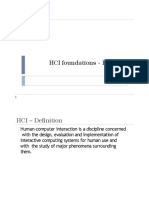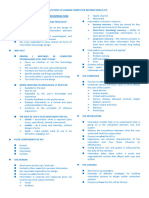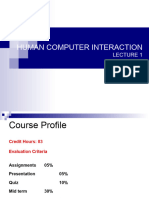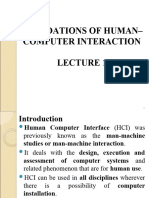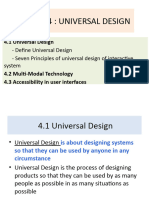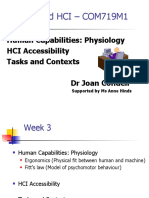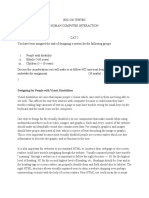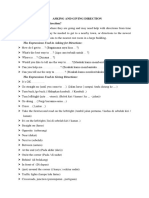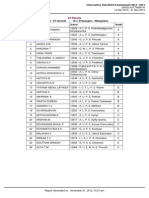Human Computer Interaction (HCI)
Input-output channels
User interacts with the world
Receives information and sends information
Using senses
Sight, hearing, touch, taste and smell
Sight, hearing & touch have important role in HCI
Effectors
Limbs (arms, legs), fingers, eyes, head and vocal system
2
� Input-output channels
Human input / output (Example)
User interacting with a PC using mouse and keyboard
Manipulating objects (icons, windows, etc.)
Receive information through vision mostly
Receive information through ears too (e.g. beep)
Provide input to PC through effectors
3
� Vision
4
� Vision
Primary source of information
Two stages in vision
Physical reception of stimulus (event)
Processing and interpretation of stimulus
5
� The Eye - physical reception
Light reflects from objects
Eyes provide a mechanism for receiving light and
Transforming it into electrical energy
6
� The Eye - physical reception
Two receptors in retina
Rods
Edges of the eye
More densely packed at the
outer parts of our visual field
For low (dim) light vision
Detect changes in movement
7
� The Eye - physical reception
Cones
Densely packed towards the center
of our visual field
Different types of cones for different
wavelengths
Help in colour vision
Help in reading and distinguishing
8
� Home work:
1- What is color blindness?
2- Types of colorblindness?
3- How colorblinds distinguish colors?
4- What are the interface design rules for colorblinds?
9
� Interpreting the visual signal
Familiar objects perceived as constant size
In spite of changes in visual angle (when far away)
Law of size constancy!
-Known object appears to be of same size, no matter how far it is from us
Thus our perception of size relies on factors other than visual
angle
Cues like overlapping help perception of size and depth
Partially covered objects appear in the background and thus
further away
10
� Interpreting the visual signal
Our expectations affect the way an
image is perceived
Context/expectations are used to
resolve ambiguity
11
� Optical Illusions
•The way things are and the way we perceive them
•Take care of distances, color schemes and the contextual objects
is
f size
o le
t i on reliab
e rcepletely
rp p
Ou t com
no
The Ponzo illusion The Muller Lyer illusion
(distance) (edges)
12
� Vision: Design Focus
How helpful in interface design?
•If you want a user to see an error message at the bottom of the screen
• It had better be flashing !
• Because rods are sensitive to changes
• Hence we see movements well at the edges of our vision
13
� Reading
14
� Reading
Several stages:
Visual pattern of the word is perceived
Encoded with reference to internal representation of knowledge
Interpreted using knowledge of syntax and semantics
15
� Reading
Reading involves “saccades” and “fixations”
Saccades:
The fast movements of both eyes in the same direction
Fixations:
Stable movement of the eye (maintaining the visual gaze at
single location)
Perception occurs during fixations
16
� Reading
Example:
Read aloud and quickly !
The quick brown
fox jumps over the
the lazy dog comp
en s ates
system
v is ual tions !
Our xpecta
e
17 our
� Reading
Words can be recognized as quickly as characters
Word shape is important to recognition
Familiar words are recognized using word shape
18
� Reading
What if we remove the word shape clues (e.g. capitalizing
words)
“ NEGATIVE CONTRAST IMPROVES READING FROM COMPUTER SCREEN ”
“ Negative contrast improves reading from computer screen ”
Reading is slower in which case?
19
� Reading
Reading Test
aocdcrnig to rseecrah at Cmabrigde Uinervtisy, it dseno't
mttaer in waht oderr the lterets in a wrod are, the olny
irpoamtnt tihng is taht the frsit and lsat ltteer be in the rhgit
pclae. The rset can be a taotl mses and you can sitll raed it
whoutit a pboerlm. Tihs is bucseae the huamn mnid deos not
raed ervey ltteer by istlef, but the wrod as a wlohe.
Can you read without difficulty?
20
� Reading
How helpful in interface design?
1. Standard font size of 9 to 12 points are equally legible, given
proportional spacing between lines
2. Line lengths of 2.3 and 5.2 inches are equally legible
3. Dark characters on light screen: increases acuity, increases legibility
4. Reading from computer screen is slower than from a book (Home work)
21
� Reading
• Minimum Design
- Use 80/20 rule, design for the top 20 percent features
-Choose aesthetic colors and layout
- Provide high noise-to-signal ratio between the chrome of the UI and
data
• Simplicity
-Keep design simple and clear
-Focus on the main task and avoid user distraction
-Keep functionality and simplicity
22
� Reading
• Accessibility
-Make easier to use and access by multiple devices, like old computers
and assistive devices
-Make usable by everyone: disabled, senior citizens, and people with low
literacy level
• Consistency
- Use similar layouts and terminology within the application
-Employ familiar interaction and navigation
-Keep the UI consistent within the context
23
� Reading
Feedback
-Provide immediate feedback
- Update user with current status for background actions
Forgiveness
-Allow for error prevention and allow undo
-Limit user error by enabling on required commands
24
� Reading
• Similar behavior of UI at different places
• Put buttons on similar places in multiple windows
• OK, Cancel, ...
25
� Reading
• Use consistent color scheme
• Colors of title bars, windows, .... (think of a theme)
26
� Reading
• Use consistent color scheme
• Colors of title bars, windows, .... (think of a theme)
27
� Reading
• MS Word users can easily use Excel, PowerPoint, ...
• Benefit
• Users can transfer knowledge/learning to a new program
28
� Hearing
29
� Hearing
Provides information about environment:
Objects
cars, birds, machinery, neighbour, …
Distances
Directions etc.
30
� Hearing
Humans can hear frequencies from 20Hz to 20kHz
Less accurate in distinguishing high frequencies than low
Auditory system filters sounds
Can attend to sounds over background noise
For example, the “cocktail party phenomenon”
Name called in the party
31
� Hearing
In interface design:
Warning sounds / Notifications
To convey information about the system state
User attention to a critical situation
Virus found / software updates (in Avast)…
32
� Hearing
In interface design:
Status information
Continuous state of a system (e.g. In hospitals)
Confirmation of an operation
Deleting a file
Supporting navigations with different sound effects
33
� Hearing
Giving immediate feedback that an action has taken
place (buttons on ATMs, telephones, etc., that "beep"
or "click" as they are pressed);
Supporting users for whom the visual interfaces are
not an option (e.g., those with visual impairments)
34
� Hearing
In interfaces where visual information cannot be
presented (e.g. mobile or handheld devices with small
or no screens).
Supporting users whose visual senses are already
heavily used for other parts of their task (e.g., aircraft
pilots)
35
� Touch
36
� Touch / Haptic perception
Provides important feedback about
environment
Hot coffee
Cold water
Pressing a button to turn on fan …
... as warning
37
� Touch / Haptic perception
What if we cant “feel” …
The shape of the glass while picking it?
Feet on the ground ?
“ Speed and accuracy of action is reduced! ”
Key sense for visually impaired
38
� Touch / Haptic perception
Stimulus received via receptors in the skin:
Thermoreceptors – heat and cold
Nociceptors – pain
Mechanoreceptors – pressure
39
� Touch / Haptic perception
Kinesthesis - awareness of body position and limbs
Affects comfort and performance e.g. touch typist
Awareness of relative position of fingers on keyboard
Tactile feedback from keyboard
40
� Touch / Haptic perception
In Virtual Reality (VR)
Games
In Touch screens
Touch tables …
In Tangible User Interfaces (TUIs)
E-commerce
The experience of shopping online !
Buying clothes / food etc...
Users need to feel surfaces and shapes
41
� Fitts’ Law
The time taken to hit (select) a screen target:
Mt = a + b log2(D/S + 1)
Where: Mt is time taken to move a pointing device to a target
a: start/stop time of the device
b: speed of the device
D is Distance from starting point to the center of the target
S is Size of target (width of the target)
42
� Fitts’ Law
This affects the type of the target we design
Targets as large as possible
Distances as small as possible
43
















